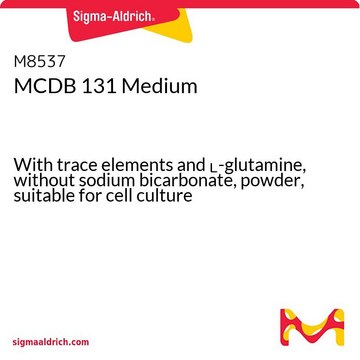Wszystkie zdjęcia(1)
Key Documents
M6770
MCDB 201 Medium
With trace elements, L-glutamine and 30 mM HEPES, powder, suitable for cell culture
Synonim(y):
MCDB medium
Zaloguj sięWyświetlanie cen organizacyjnych i kontraktowych
About This Item
Kod UNSPSC:
41161501
NACRES:
NA.75
Polecane produkty
Poziom jakości
Postać
powder
metody
cell culture | mammalian: suitable
komponenty
HEPES: 7.149 g/L (30mM)
glucose: 1.441 g/L (Dextro)
phenol red: 0.001242 g/L
sodium pyruvate: 0.055 g/L
L-glutamine: 0.14615 g/L
Warunki transportu
ambient
temp. przechowywania
2-8°C
Opis ogólny
MCDB 201 medium is a modified Ham′s nutrient mixture F-12 that is synthesized for the clonal growth of chicken embryo fibroblasts.
Zastosowanie
MCDB 201 Medium has been used as a component of:
- the hepatic differentiation medium to culture pluripotent stem cells,
- epididymal growth medium for culturing of preadipocytes,
- Dulbecco′s Modified Eagle Medium (DMEM)/F12 for culturing of human umbilical cord mesenchymal stem cells
Ilość
Formulated to contain 17.7 grams of powder per liter of medium.
This page may contain text that has been machine translated.
suplement
Kod klasy składowania
11 - Combustible Solids
Klasa zagrożenia wodnego (WGK)
WGK 1
Temperatura zapłonu (°F)
Not applicable
Temperatura zapłonu (°C)
Not applicable
Certyfikaty analizy (CoA)
Poszukaj Certyfikaty analizy (CoA), wpisując numer partii/serii produktów. Numery serii i partii można znaleźć na etykiecie produktu po słowach „seria” lub „partia”.
Masz już ten produkt?
Dokumenty związane z niedawno zakupionymi produktami zostały zamieszczone w Bibliotece dokumentów.
Klienci oglądali również te produkty
Jeff Ishibashi et al.
Molecular and cellular biology, 32(12), 2289-2299 (2012-04-05)
Fibroblastic preadipocyte cells are recruited to differentiate into new adipocytes during the formation and hyperplastic growth of white adipose tissue. Peroxisome proliferator-activated receptor γ (PPARγ), the master regulator of adipogenesis, is expressed at low levels in preadipocytes, and its levels
Baris Ulum et al.
Journal of cellular physiology, 233(11), 8429-8436 (2018-05-26)
Bone marrow mesenchymal stem cells (BM-MSCs) are promising candidates for regenerative medicine purposes. The effect of obesity on the function of BM-MSCs is currently unknown. Here, we assessed how obesity affects the function of BM-MSCs and the role of endoplasmic
Philip Roelandt et al.
Methods in molecular biology (Clifton, N.J.), 997, 141-147 (2013-04-03)
Differentiation of human stem cells to hepatocytes is crucial for industrial applications as well as to develop new therapeutic strategies for liver disease. The protocol described here, using sequentially growth factors known to play a role in liver embryonic development
Philip Roelandt et al.
PloS one, 5(8), e12101-e12101 (2010-08-17)
Stem cell-derived hepatocytes may be an alternative cell source to treat liver diseases or to be used for pharmacological purposes. We developed a protocol that mimics mammalian liver development, to differentiate cells with pluripotent characteristics to hepatocyte-like cells. The protocol
C-S Bao et al.
European review for medical and pharmacological sciences, 22(19), 6436-6447 (2018-10-20)
This research aimed to investigate the therapeutic effects of transplanted human umbilical cord mesenchymal stem cells (hUCMSCs) on spinal cord injury in mice and to explore its molecular mechanism. Spinal cord injury model in C57BL/6J mice was established. On the
Nasz zespół naukowców ma doświadczenie we wszystkich obszarach badań, w tym w naukach przyrodniczych, materiałoznawstwie, syntezie chemicznej, chromatografii, analityce i wielu innych dziedzinach.
Skontaktuj się z zespołem ds. pomocy technicznej









